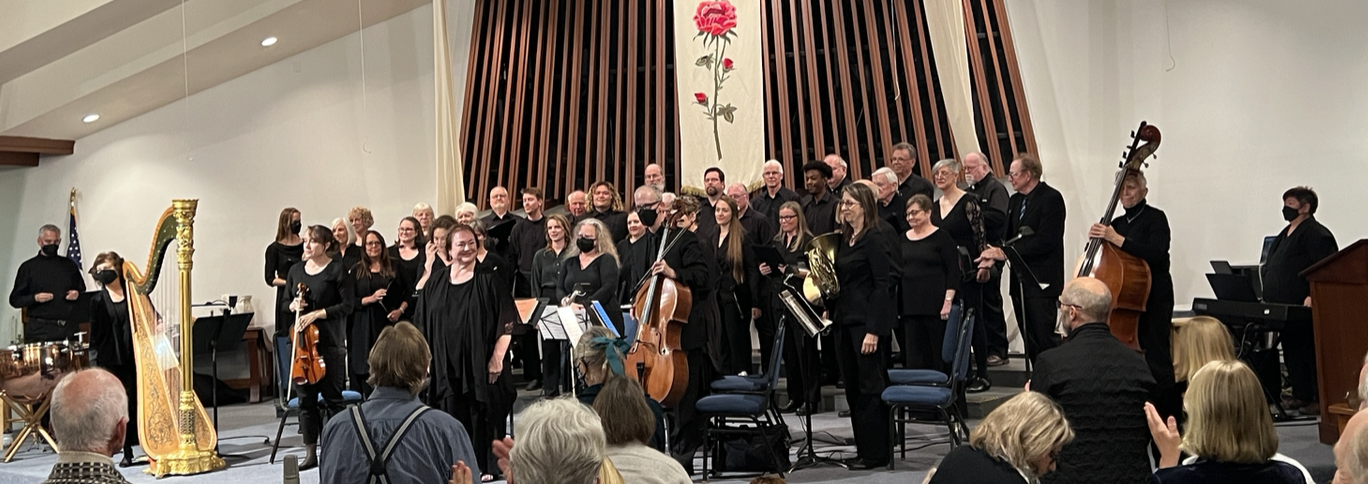|
Chamber
FAMILIAR AND NEW - TRIO NAVARRO'S SPRING CONCERT IN WEILL
by Terry McNeill
Sunday, April 21, 2024
Symphony
MONUMENTAL MAHLER 5TH IN SO CO PHIL'S SEASON ENDING CONCERT
by Terry McNeill
Sunday, April 14, 2024
Chamber
OAKMONT SEASON CLOSES WITH STRAUSS' PASSIONATE SONATA
by Terry McNeill
Thursday, April 11, 2024
Chamber
MORE GOLD THAN KORN AT ALEXANDER SQ CONCERT
by Terry McNeill
Sunday, April 7, 2024
Choral and Vocal
VIBRANT GOOD FRIDAY REQUIEM AT CHURCH OF THE ROSES
by Pamela Hicks Gailey
Friday, March 29, 2024
TWO OLD, TWO NEW AT THE SR SYMPHONY'S MARCH CONCERT IN WEILL
by Peter Lert
Saturday, March 23, 2024
Chamber
NOT A SEVENTH BUT A FIRST AT SPRING LAKE VILLAGE CONCERT
by Terry McNeill
Wednesday, March 20, 2024
THIRTY-THREE PLUS VARIATIONS AND AN OCEAN VIEW
by Terry McNeill
Saturday, March 16, 2024
Choral and Vocal
A ST. JOHN PASSION FOR THE AGES
by Abby Wasserman
Friday, March 8, 2024
Choral and Vocal
SPLENDID SCHUBERT SONGS IN SANET ALLEN RECITAL
by Terry McNeill
Saturday, March 2, 2024
|
 |
 Carol Menke and Cantiamo Sonoma April 15 |
A SPIRITUAL FAURE REQUIEM IN GOOD FRIDAY CANTIAMO CONCERT
by Pamela Hicks Gailey
Friday, April 15, 2022
A lovely and emotional rendering of Fauré's beloved Op. 48 Requiem was presented on Good Friday by Cantiamo Sonoma at Santa Rosa's Church of the Roses. The singers of Cantiamo were joined by members of the The Roses Chancel Choir and Chamber orchestra to create a powerful yet tender and memorable performance. Carol Menke was the formidable director of this well-prepared and focused offering.
Although the piece clocks in at under an hour, it is musically and emotionally full and needed no other "curtain warmers" to increase the length of the proceedings. Good Friday (April 15) is a thoughtful, melancholy day in the Christian calendar and a requiem for the dead is not really a concert, it is a service. The audience was definitely in the mood and showed their appreciation generously at the close.
There are many magnificent requiem settings by many great eighteenth and nineteenth century composers, but dare I say, there may be none more beloved by community and church choruses than Fauré's little gem. Known primarily for his output of gorgeous and popular mélodies (art songs) his music is exquisitely lyric and vocally gratifying. Like Brahms' Deutsches Requiem it describes musically more the comfort and peace to be found in and after death, rather than the trembling, death and destruction promised by a wrathful God. It is painted with flowing delicate lines and gently and compassionately communicates its woeful-triumphant message. There are no massive fugues, no vocal gymnastics to be tackled, and even the Sanctus, although thrilling, does not shout. The Dies Irae and Libera Me are given a relatively muted treatment, compared with the requiems of Berlioz, Verdi, or Mozart.
This requiem is intentionally brief, the text of the mass edited and altered by Fauré himself. He shortened the Dies Irae portion considerably and chose to end with In Paradisum which is not a part of the regular requiem text. The resulting order is Requiem, Kyrie, Offertorium, Sanctus, Pie Jesu, Agnus Dei, Libera Me and the transcendent In Paradisum. The composer’s prominent musical signature throughout is his generous use of all the seventh chords: major, minor, diminished, dominant, and the open major seventh, a new addition to the late nineteenth century harmonic palette. They are sometimes clearly resolved, and sometimes left hanging, which gives an inquiring flavor to the music, as if the music itself is asking what happens at death, and what is yet to come afterwards.
There are three versions of this requiem: full orchestra plus organ, organ only, or with organ and chamber orchestra (string ensemble, horns, timpani, harp). This performance featured the latter and it was perfectly suited to the combined resources and acoustics in the church. The sound was balanced, full and rich where it needed to be, and ethereal in the quiet sections. The string ensemble played with an aching tenderness.
Ms. Menke is a powerhouse musician and conductor. If I say she conducts like a singer, it is meant as the highest compliment. She maintained a light brisk pace without sacrificing any nuance or emotion, controlling and inspiring a tight legato, marked dynamic contrasts and strict tempo through a physically focused and restrained conducting style. I only wish I could have seen her from the chorus's view! As a result the chorus and orchestra sang and played with a graceful impetus and resounding energy. Diction throughout was outstanding, and I sat in the Church’s rear pews and understood almost every word. Harmonies were full and the intonation excellent. The sopranos blended impeccably, particularly in the exposed floating solo lines of the ethereal last movement, with harpist Wendy Tamis providing heavenly accompaniment.
Likewise for the excellent soloists, both of whom joined the chorus and stepped forward for their solos. Baritone Gene Wright sang masterfully with forthrightness and ministerial warmth, and soprano Claire Frydenlund's pure-voiced, childlike and simple delivery of the Pie Jesu was simply angelic.
|

